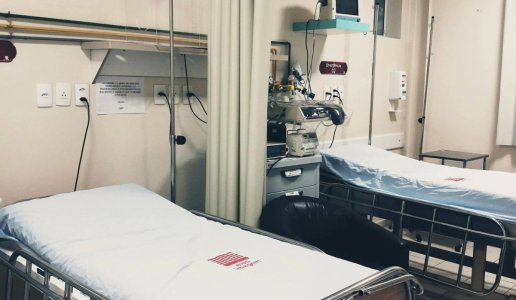Rural hospitals face uncertain future amid Medicaid funding changes
By
Veronica E.
- Replies 0
For many people living in rural areas, nearby hospitals provide a crucial safety net—especially when emergencies arise and time is critical.
Recent changes to federal Medicaid funding have raised questions about how long some of these facilities can continue operating.
While the overall impact will unfold over time, health care leaders and policymakers are already expressing concern.
Hospitals, clinics, and nursing homes in smaller communities could face difficult decisions as financial pressures grow.
Here’s a closer look at what’s changing, who may be affected, and what steps are being taken in response.

In 2013, Penny Blue of Union Hall, Virginia, experienced a brain aneurysm.
A nearby hospital just 15 minutes away was able to stabilize her before she was airlifted to a larger medical center for care.
She spent nearly two weeks in intensive care and made a full recovery.
Today, she wonders what might happen if the same thing occurred again—especially if her local hospital were to close.
“Time, minutes and seconds, make a difference whether you live or die—and if you live, the quality of your life,” Penny told USA TODAY.
Many rural hospitals rely heavily on Medicaid reimbursements to operate, particularly for long-term care, emergency services, and support for older adults and people with disabilities.
Rural Americans use Medicaid at higher rates than those in urban areas, according to health policy researchers.
A recently passed federal spending bill, signed on July 4, includes reductions in Medicaid spending over the next decade.
Analysts estimate rural areas could see losses totaling more than $155 billion.
According to hospital advocacy groups, approximately one in three rural hospitals—roughly 700 facilities—could be at risk of closure if long-term funding pressures aren’t addressed.
It’s not just hospitals feeling the impact—clinics, specialty care providers, and nursing homes that serve rural populations are also reporting financial strain.
Retired nurse Denise Parashac, who worked in a rural Pennsylvania hospital, said, “Having that rural hospital in that area is really a life saver.”
When care facilities close, patients often need to travel farther, which can delay treatment or limit access to services like cancer screenings, mental health support, or prenatal care.
In Craig, Colorado, for example, the local hospital has closed its OB/GYN and maternity units.
Expectant mothers now travel an hour or more to reach a delivery center.
Other departments in similar communities may face reductions in service as well.
Hospitals are also major employers in rural areas.
When one closes, the economic effects may include job losses, declining property values, and reduced appeal for new residents and businesses.

To address concerns, Congress has created a $50 billion rural health transformation program, intended to support access and innovation over five years.
However, health experts and analysts have pointed out that the program’s funding is not exclusively reserved for rural hospitals and may not fully offset expected cuts or rising care costs.
Some states are taking independent action.
Colorado, for instance, introduced a $25 million provider stabilization fund—a smaller effort compared to the $800 million in annual Medicaid funding the state projects to lose.
Michigan faces a $5.6 billion shortfall over 10 years.
“There really isn’t much,” said Michigan State Senator Sarah Anthony, when asked about what states can do to completely close the gap.
Behind the policy and financial forecasts are everyday residents who rely on nearby care.
While it’s difficult to predict how every community will be affected, many local leaders and medical professionals are watching developments closely.
Medicaid also covers more than 60% of long-term care residents nationwide, according to federal data.
Families in some regions are beginning to plan for possible changes to care options, particularly for loved ones with ongoing medical needs.

For individuals and families in rural areas, there are several ways to stay proactive:
Access to health care is a concern that touches every community, whether urban or rural.
As policy shifts continue to shape the future of Medicaid and local health systems, staying informed and engaged will be key.
While challenges remain, many communities are working together to explore solutions, support providers, and ensure that care remains within reach.
Read next: Millions set to lose government health coverage after new tax law takes effect

Have you seen changes to your local health care access in recent years? Are you concerned about future availability of services where you live? We welcome your stories, questions, and feedback in the comments below.
Recent changes to federal Medicaid funding have raised questions about how long some of these facilities can continue operating.
While the overall impact will unfold over time, health care leaders and policymakers are already expressing concern.
Hospitals, clinics, and nursing homes in smaller communities could face difficult decisions as financial pressures grow.
Here’s a closer look at what’s changing, who may be affected, and what steps are being taken in response.

Rural hospitals often serve as vital hubs for emergency care, routine checkups, and long-term treatment in smaller communities across the country. Image Source: Pexels / Sals.
A firsthand story of why minutes matter
In 2013, Penny Blue of Union Hall, Virginia, experienced a brain aneurysm.
A nearby hospital just 15 minutes away was able to stabilize her before she was airlifted to a larger medical center for care.
She spent nearly two weeks in intensive care and made a full recovery.
Today, she wonders what might happen if the same thing occurred again—especially if her local hospital were to close.
“Time, minutes and seconds, make a difference whether you live or die—and if you live, the quality of your life,” Penny told USA TODAY.
Also read: Nearly 1.8 million Texans have lost Medicaid coverage—here’s what that means for health care access
Understanding the funding challenge
Many rural hospitals rely heavily on Medicaid reimbursements to operate, particularly for long-term care, emergency services, and support for older adults and people with disabilities.
Rural Americans use Medicaid at higher rates than those in urban areas, according to health policy researchers.
A recently passed federal spending bill, signed on July 4, includes reductions in Medicaid spending over the next decade.
Analysts estimate rural areas could see losses totaling more than $155 billion.
According to hospital advocacy groups, approximately one in three rural hospitals—roughly 700 facilities—could be at risk of closure if long-term funding pressures aren’t addressed.
It’s not just hospitals feeling the impact—clinics, specialty care providers, and nursing homes that serve rural populations are also reporting financial strain.
Also read: Could changes to Medicaid funding put your local hospital in danger?
More than a health care issue
Retired nurse Denise Parashac, who worked in a rural Pennsylvania hospital, said, “Having that rural hospital in that area is really a life saver.”
When care facilities close, patients often need to travel farther, which can delay treatment or limit access to services like cancer screenings, mental health support, or prenatal care.
In Craig, Colorado, for example, the local hospital has closed its OB/GYN and maternity units.
Expectant mothers now travel an hour or more to reach a delivery center.
Other departments in similar communities may face reductions in service as well.
Hospitals are also major employers in rural areas.
When one closes, the economic effects may include job losses, declining property values, and reduced appeal for new residents and businesses.

Penny Blue of Union Hall, Virginia, credits a nearby hospital with saving her life after a brain aneurysm—now she worries what might happen if that hospital were to close. Image Source: AOL / USA TODAY.
Also read: Is your healthcare at risk? Millions could lose coverage if Medicaid cuts become law
Federal and state responses underway
To address concerns, Congress has created a $50 billion rural health transformation program, intended to support access and innovation over five years.
However, health experts and analysts have pointed out that the program’s funding is not exclusively reserved for rural hospitals and may not fully offset expected cuts or rising care costs.
Some states are taking independent action.
Colorado, for instance, introduced a $25 million provider stabilization fund—a smaller effort compared to the $800 million in annual Medicaid funding the state projects to lose.
Michigan faces a $5.6 billion shortfall over 10 years.
“There really isn’t much,” said Michigan State Senator Sarah Anthony, when asked about what states can do to completely close the gap.
Also read: Medicaid rollbacks could quietly affect your housing and food support—what to know
Real people behind the headlines
Behind the policy and financial forecasts are everyday residents who rely on nearby care.
While it’s difficult to predict how every community will be affected, many local leaders and medical professionals are watching developments closely.
Medicaid also covers more than 60% of long-term care residents nationwide, according to federal data.
Families in some regions are beginning to plan for possible changes to care options, particularly for loved ones with ongoing medical needs.

Retired nurse Denise Parashac emphasizes the importance of local hospitals, calling them “a life saver” for rural communities facing longer travel times for care. Image Source: AOL / USA TODAY.
Also read: Budget dilemma: Proposed cuts could hit Medicare and Medicaid, affect millions
Staying informed and involved
For individuals and families in rural areas, there are several ways to stay proactive:
- Stay informed: Learn about any changes affecting hospitals and care centers in your region.
- Reach out: Ask local and state officials about contingency plans and available programs.
- Support local care: Participate in health initiatives or fundraising efforts that benefit local clinics and facilities.
- Plan ahead: If you or a loved one depends on a nearby hospital, discuss alternative care options with your doctor.
Access to health care is a concern that touches every community, whether urban or rural.
As policy shifts continue to shape the future of Medicaid and local health systems, staying informed and engaged will be key.
While challenges remain, many communities are working together to explore solutions, support providers, and ensure that care remains within reach.
Read next: Millions set to lose government health coverage after new tax law takes effect
Key Takeaways
- Rural hospitals and clinics across the US are facing pressure due to recent changes in federal Medicaid funding, with long-term cuts projected to total over $155 billion.
- Around one in three rural hospitals may be at risk of closure, according to advocacy groups, potentially affecting access to emergency care, maternity services, and long-term care.
- Congress has established a $50 billion rural health initiative, but analysts say it may not fully offset the funding reductions or rising care costs.
- Several states are launching their own stabilization efforts, though many leaders acknowledge these steps may be limited in scope.
Have you seen changes to your local health care access in recent years? Are you concerned about future availability of services where you live? We welcome your stories, questions, and feedback in the comments below.






